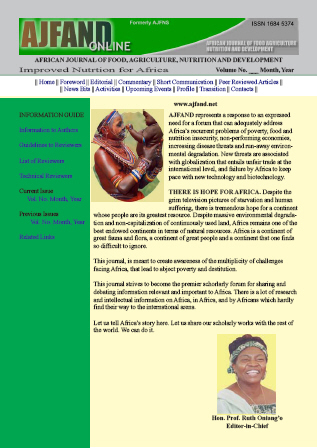
|
African Journal of Food, Agriculture, Nutrition and Development
Rural Outreach Program
ISSN: 1684-5358
EISSN: 1684-5358
Vol. 20, No. 2, 2020, pp. 15637-15659
|
 Bioline Code: nd20030
Bioline Code: nd20030
Full paper language: English
Document type: Research Article
Document available free of charge
|
|
|
African Journal of Food, Agriculture, Nutrition and Development, Vol. 20, No. 2, 2020, pp. 15637-15659
| en |
RECOMMENDED MODIFICATION OF PORRIDGE AND MIXTURE TO IMPROVE NUTRIENT INTAKE IN THE RURAL AREA OF NORTHERN RWANDA
Tanno, Y; Sudo, N; Kano, M; Mukuralinda, A; Mukantwali, C; Mujawamariya, P; Ruganzu, V & Iiyama, M
Abstract
In Rwanda, nutritional problems are increasingly drawing attention, and the National
Nutrition Policy focuses on the solutions to reduce the prevalence of malnutrition and to
improve household food intake. Since rural Rwandans typically have meals at home and
household food intake is known to be affected by their socioeconomic status (SES), care
should be taken to ensure that homemade meals are healthy. This study aimed to assess
the current nutrient content of porridge and mixture so as to recommend modifications
to be made to improve nutrient intake within rural households in Rwanda. A cross-sectional
study was conducted; anthropometric measurements and one-day weighed food
records (WFRs) were collected from 30 participants in four households with different
SES in the Musanze district in the Northern Province of Rwanda. The first objective of
this study was to compare nutritional status and food intake among households with
different SES. The study results indicated that SES did not solely explain the nutritional
status of the household members, and co-existence of over-nutrition and undernutrition
was observed within the better-off household. Although meal frequency per day and the
number of dishes and ingredients were positively related to household SES, rural
Rwandans consumed monotonous diets characterized by porridge for breakfast and
mixture (a dish boiled some foods together) for lunch and dinner as a whole. These two
familiar dishes, porridge and mixture, greatly affected their energy and nutrient intakes.
The second objective was to compare energy and nutrient contents in the same dishes
with different ingredients and cooking methods. Porridges were made by dissolving
mixed flour (maize and sorghum flours) in hot water. The porridge did not contain
vitamin A. The energy, protein, and iron contents of the porridge were affected by flour
concentration. Thick porridge whose flour concentration is 13% is recommended. Beans
and potatoes were popular ingredients of mixture. Beans were major sources of energy,
protein, and iron intakes. Contrary to general assumption, roots and tubers were also the
major sources of protein and iron intakes among the participants. To cook mixture that is
well boiled and contains beans and potatoes is a feasible way to increase energy and
nutrient intakes regardless of household SES. In order to provide good vitamin A intake,
addition of yellow plantain, palm oil, and/or tomato is recommended. This study presents
locally and economically feasible recommendations to make popular dishes more
nutritious for rural Rwandans.
Keywords
Household food intake; socioeconomic status; ingredients; cooking methods; rural Rwanda
|
| |
© Copyright [2020] - African Journal of Food, Agriculture, Nutrition and Development
Alternative site location: http://www.ajfand.net/
|
|
